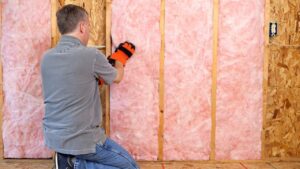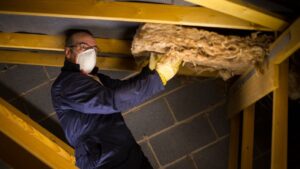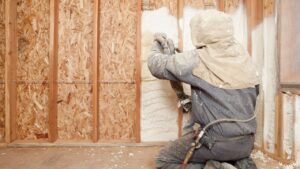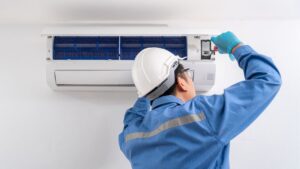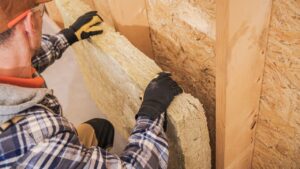Looking to see which attic insulation is best? No matter how big your home is, it needs proper insulation to help regulate temperature and save on the utility bill. So, if you live in a freezing area with snowy winters, you need to have your attic insulated for better energy efficiency.
Still, what attic insulation is best? The truth is you can find different types of insulation, and not one size fits all. But we here at Universal Insulation Doctor can help determine what will work best for your attic.
It All Comes Down to The R-Value
For proper attic insulation, you need to understand the R-Value of a unit that attic insulation contractors use to determine the strength of the insulation. The R-Value is the capacity of the material and how it resists or transfers heat to heat loss.
Hence, the R-Value gets affected by the type of material, the thickness, density, and where you plan to install it. So the higher the R-Value can trap heat flow better to prevent your home from turning into a freezer during winter or a sauna in the scorching heat.
The recommended R-Value levels for the attic, according to the US Department of Energy, are as follows:
- In warm climates, it is R30
- For temperate climate, it is R38
- And for a freezing environment, it is R49
Type of Insulation Material Used for Attics
While having a higher R-Value used in the insulation material, it doesn’t mean it is the best insulation choice for the attic in your home. You can find different insulation materials with outstanding strengths and weaknesses. Furthermore, some attics might work best with a specific fabric. So, you can find the following attic insulation materials used often:
Fiberglass
The material is not your highest quality option but remains popular to use. The R-Value ranges from 2.2 up to 4.3 when using high-density fiberglass. So, attic insulation performs at its worst even when used in insulation construction with home renovations.
The main advantage of fiberglass is that it is affordable and helps expert moisture that helps in high humidity areas. Neither does the fabric shrink; it is fire-resistant, while bugs avoid chewing on it.
Cellulose
You find cellulose attic insulation in the form of recycled paper or wood, claiming it is a green product, yet most of the time, it does not pass the green assessment. Furthermore, there are concerns as it is a natural flammable product even if treated with anti-flammable chemicals.
So, it is a fire hazard compared to using fiberglass, but it is inexpensive and 25% cheaper than fiberglass. Hence, it has more negatives than benefits:
- First, it does not do well with moisture and is rendered useless when wet as it collects and holds water. Thus, you can find it develops mildew and mold with time.
- Cellulose also sags with time and works better with wall insulation than in the attic.
- Lastly, it creates a lot of dust when installed.
Mineral Wool
The fabric is a melted-down stone from steel mills and is mainly used throughout Canada and Europe. The attic insulation material is costly but has loads of advantages. First, it creates a fire barrier as it only starts to burn at 1,8000°, and every home is safe.
It is a water warrior as it is water-resistant even with the worst leak. Furthermore, it creates a sound barrier to block outside noise. But it does have one drawback, and that is inhaling it during the insulation is cancerous.
Hence, you must proceed with extra caution when present with the insulation.
Cotton/Denim Insulation
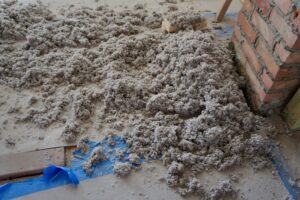
Yes, this form of attic insulation comes from recycled blue jeans. It is also viable insulation as it has high performance with an R-Value of 3.7 and above. In addition, it can trap heat and is safe compared to other materials. But it is expensive.
Open and Closed Foam Insulation
You can find two types of foam used: open and closed. Open cell foam presents you with an R-Value of 3.5 while the closed cell is a whopping R7. Yet, this form of insulation is not recommended in residential buildings and is more for commercial to industrial use.
You get exceptional air leakage to prevent and help to expand your building envelope at the attic roofline and help if your HVAC systems are found at floor level. Furthermore, it works well with water and is impenetrable to it.
Hence, you will have less mold and mildew building, which is durable as it never loses efficiency to last decades. The foam also serves a dual purpose as you can apply it to rooflines to fortify the structure and block sound.
But it can hit your wallet hard. In addition, it can shrink and requires a professional installer to do it for you. Still, that is not all, as you can find different types of attic insulation methods as well.
Popular Insulation Methods Used in The Attic
Attic insulation you can do in four ways to achieve the best results.
Batt Insulation Method
You get the batts in rolled-up sheets with interweaving fibers held in place with adhesive binders. You find it available in fiberglass, mineral wool, or denim. These types of insulation work well in attics as it covers an extensive range.
It works well with little to no obstruction on the floor with enough headroom to work. There should not be prior insulation, and it needs to have horizontal wooden rods to run the fabric between.
Blown-In Insulation
It is also known as loose-fill insulation packaged as tiny chunks in huge bags with a blowing machine. The fabric comprises fiberglass or mineral wool and is perfect for filling those tight voids in the attic.
Spray Foam Attic Insulation
The spray foam is typically paired with blanket insulation to help seal gaps. It is an effective way for attic insulation. The foam you spray into cracks creates a solid foam, while blanket insulation is inexpensive to use on floors and walls. The thick blanket pieces fit between gaps in the wooden frames or around pipes, and more.
Final Thoughts
These are some of the best attic insulation you can find and how much you need to the price depends on where you live and how old your home is. We recommend you contact us here at Universal Insulation Doctor to provide a free estimate to have your attic insulation done. Together we will look at different options to suit your budget.

